1974 CHEVROLET CAMARO oil type
[x] Cancel search: oil typePage 44 of 85
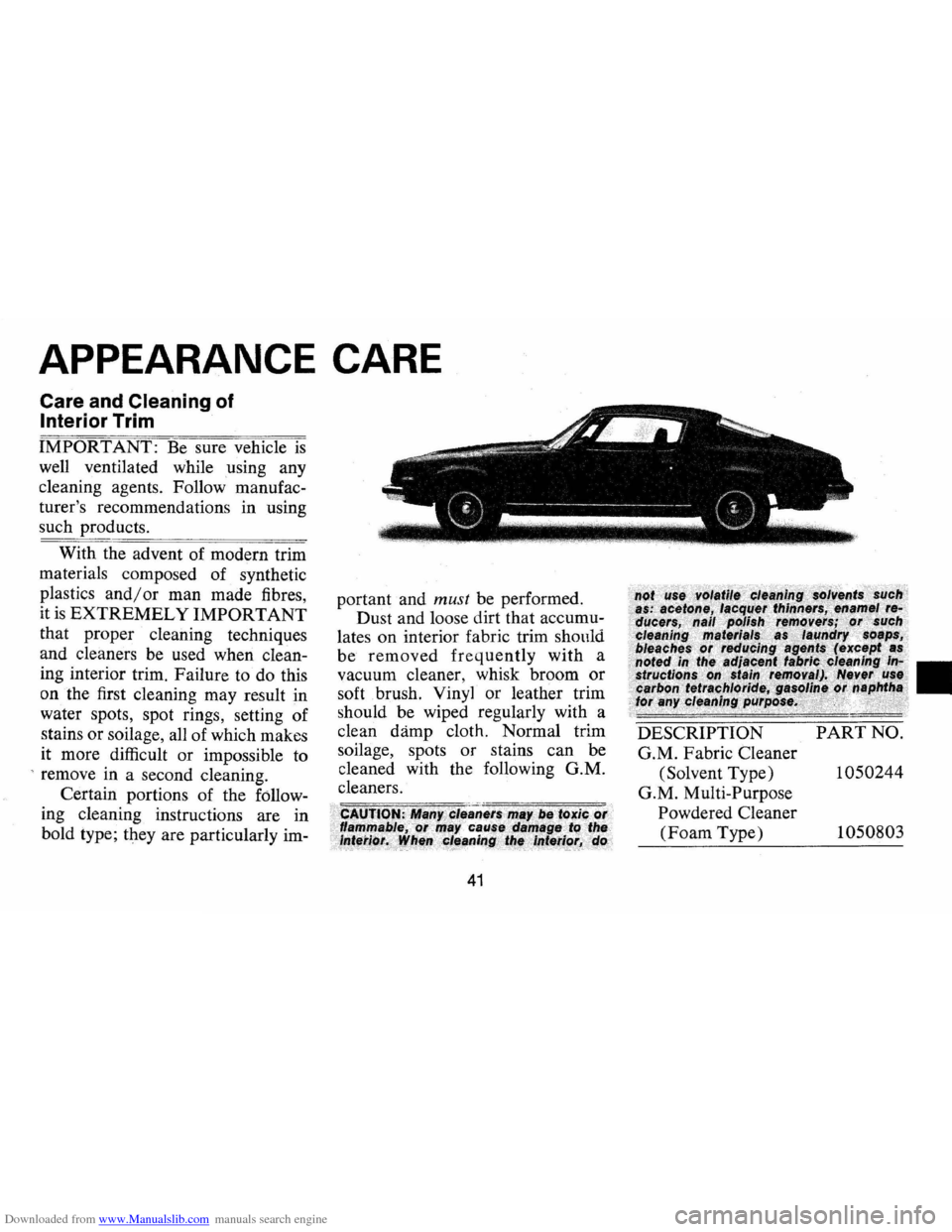
Downloaded from www.Manualslib.com manuals search engine APPEARANCE CARE
Care and Cleaning of
Interior Trim
IMPORTANT: Be sure vehicle is
well ventilated while using any
cleaning agents. Follow manufac
turer's recommendations in using
such products.
With the advent of modern trim
materials composed of synthetic
plastics and/or man made fibres,
it
is EXTREMELY IMPORTANT
that proper cleaning techniques
and cleaners
be used when clean
ing interior trim. Failure to do this
on the first cleaning may result in
water spots, spot rings, setting of
stains or soilage, all of which makes
it more difficult or impossible to
, remove in a second cleaning.
Certain portions of the follow
ing cleaning instructions are in
bold type; they are particularly im-
portantand must be performed.
Dust and loose dirt that accumu
lates on interior fabric trim
should
be removed frequently with a
vacuum cleaner, whisk broom or
soft brush. Vinyl or leather trim
should be wiped regularly with a
clean
damp cloth. Normal trim
soilage, spots
or stains can be
cleaned with the following G.M.
cleaners.
41
DESCRIPTION PART NO.
G.M. Fabric Cleaner
(Solvent Type)
1050244
G.M. Multi-Purpose
Powdered Cleaner
(Foam Type) 1050803
Page 45 of 85
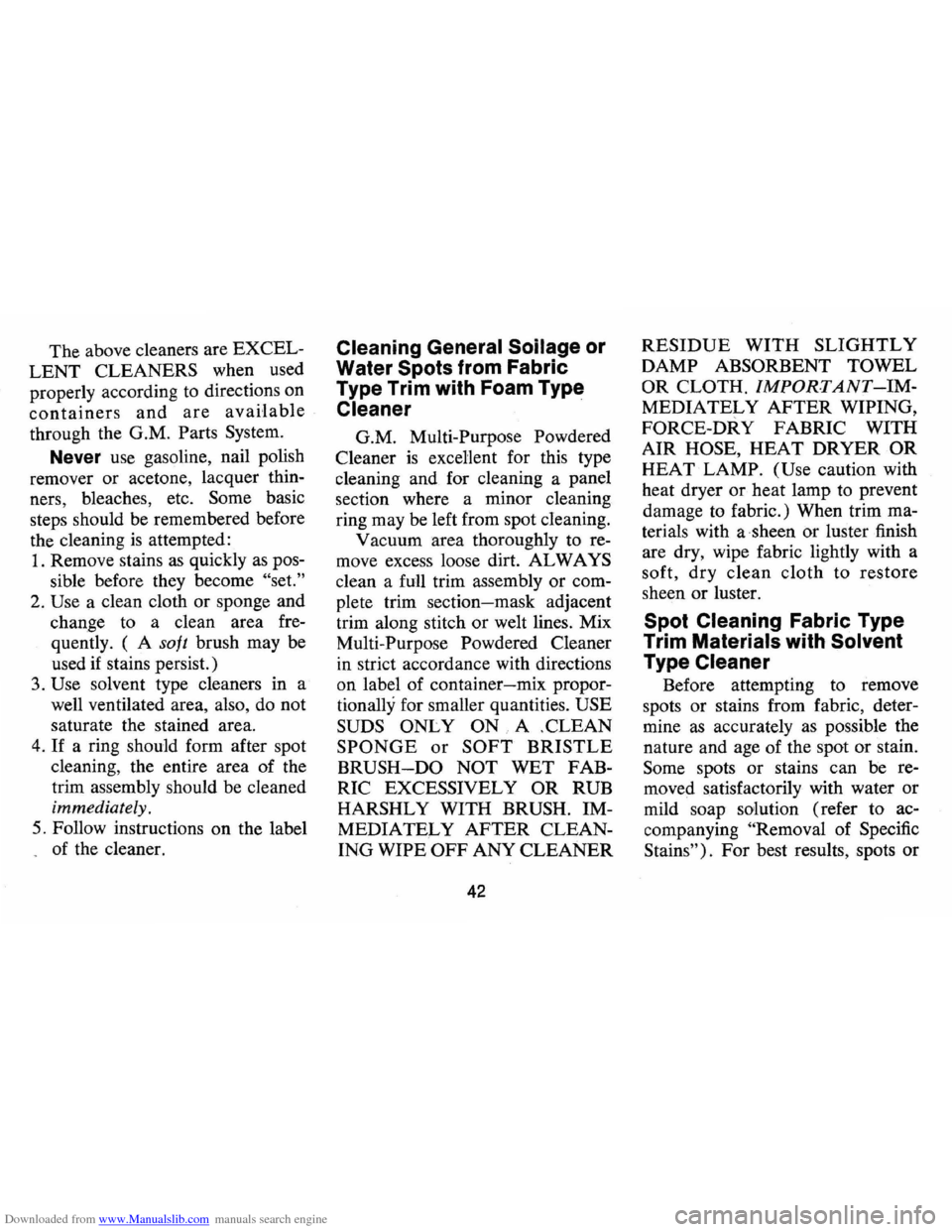
Downloaded from www.Manualslib.com manuals search engine The above cleaners are EXCEL
LENT CLEANERS when used
properly according to directions on
containers and are available
through the G.M. Parts System.
Never use gasoline, nail polish
remover
or acetone, lacquer thin
ners, bleaches, etc.
Some basic
steps should be remembered before
the cleaning
is attempted:
1. Remove stains as quickly as pos
sible before they become
"set."
2. Use a clean cloth or sponge and
change to a clean area fre
quently. ( A
soft brush may be
used
if stains persist.)
3. Use solvent type cleaners in a
well ventilated area, also, do not
saturate the stained area.
4. If a ring should form after spot
cleaning, the entire area of the
trim assembly should be cleaned
immediately.
5. Follow instructions on the label
> of the cleaner.
Cleaning General Soilage or
Water
Spots from Fabric
Type Trim with Foam Type
Cleaner .
G.M. Multi-Purpose Powdered
Cleaner
is excellent for this type
cleaning and for cleaning a panel
section where a minor cleaning
ring may be left from spot cleaning.
Vacuum area thoroughly to re
move excess loose dirt.
AL WAYS
clean a full trim assembly or com
plete trim section-mask adjacent
trim along stitch
or welt lines. Mix
Multi-Purpose Powdered Cleaner
in strict accordance with directions
on label of container-mix propor
tionally for smaller quantities.
USE
SUDS ONLY
ON A .CLEAN
SPONGE or SOFT BRISTLE
BRUSH-DO NOT WET FAB
RIC
EXCESSIVELY OR RUB
HARSHLY WITH BRUSH. IM
MEDIATELY
AFTER CLEAN
ING WIPE
OFF ANY CLEANER
42
RESIDUE WITH SLIGHTLY
DAMP ABSORBENT TOWEL
OR CLOTH.
IMPORTANT-IM
MEDIA TEL Y AFTER WIPING,
FORCE-DRY FABRIC WITH
AIR
HOSE, HEAT DRYER OR
HEAT LAMP. (Use caution with
heat dryer or heat lamp to prevent
damage to fabric.) When trim ma
terials with a sheen or luster finish
are dry, wipe fabric lightly with a
soft,
dry clean cloth to restore
sheen or luster.
Spot Cleaning Fabric Type
Trim
Materials with Solvent
Type Cleaner
Before attempting to remove
spots or stains from fabric, deter
mine
as accurately as possible the
nature and age of the spot or stain.
Some spots or stains can be re
moved satisfactorily with water
or
mild soap solution (refer to ac
companying
"Removal of Specific
Stains"). For best results , spots or
Page 46 of 85
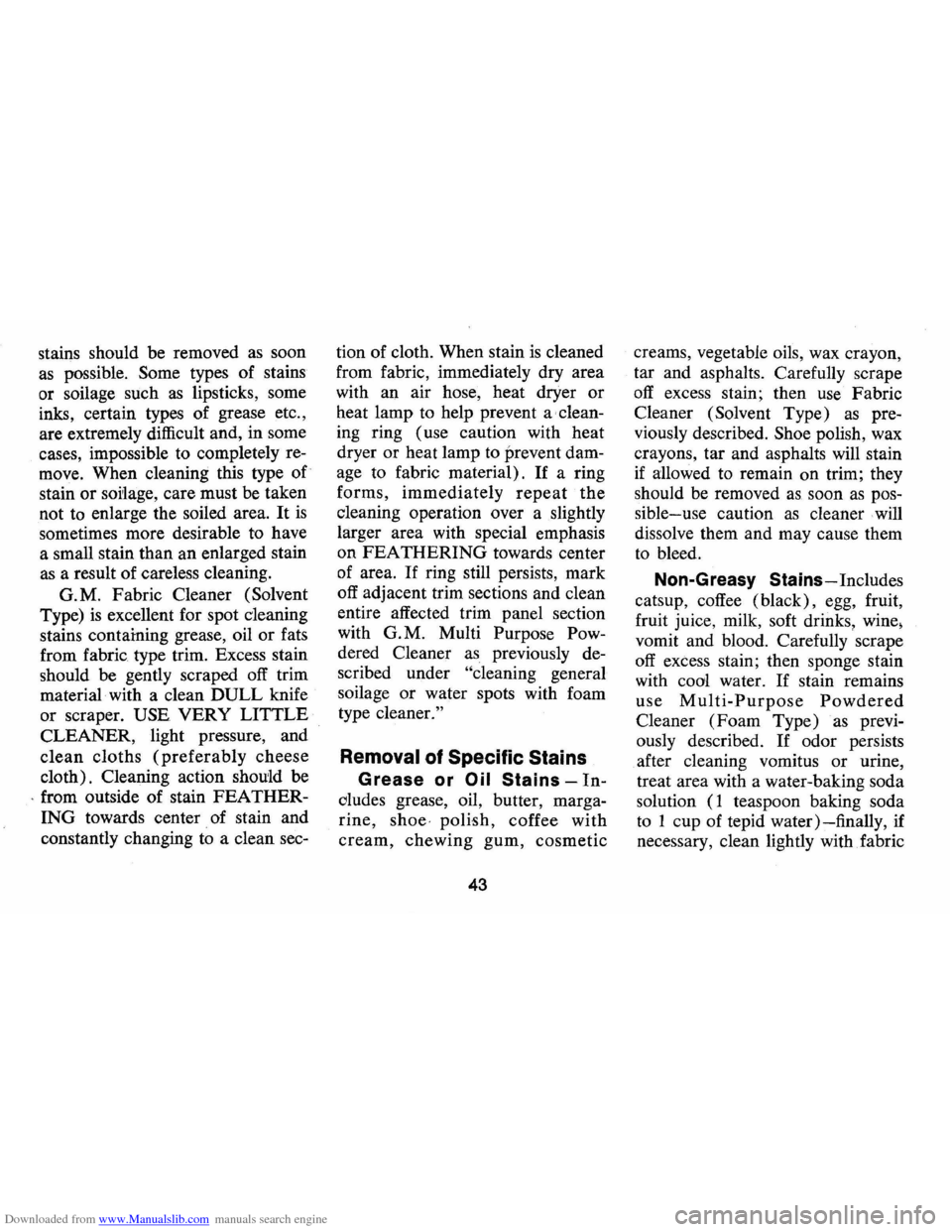
Downloaded from www.Manualslib.com manuals search engine stains should be removed as soon
as possible. Some types of stains
or soilage such
as lipsticks, some
inks, certain types of grease etc.,
are extremely difficult and, in some
cases, impossible to completely re
move. When cleaning this type
of'
stain or soi'lage, care must be taken
not to enlarge the soiled area.
It is
sometimes more desirable to have
a small stain than an enlarged stain
as a result of careless cleaning.
G.M. Fabric Cleaner (Solvent
Type)
is excellent for spot cleaning
stains containing grease, oil or fats
from fabric type trim. Excess stain
should be gently scraped off trim
material with a clean
DULL knife
or scraper.
USE VERY LITTLE
CLEANER, light pressure, and
clean cloths (preferably cheese
cloth). Cleaning action should be
, from outside of stain FEATHER
ING towards center of stain and
constantly changing to a clean sec- tion
of cloth. When stain
is cleaned
from fabric, immediately dry area
with an air hose, heat dryer or
heat lamp to help prevent a clean
ing ring (use caution with heat
dryer or heat lamp to prevent dam
age to fabric material).
If a ring
forms,
immediately repeat the
cleaning operation over a slightly
larger area with special emphasis
on
FEATHERING towards center
of area.
If ring still persists, mark
off adjacent trim sections and clean
entire affected trim panel section
with G.M. Multi Purpose Pow
dered Cleaner as previously de
scribed under
"cleaning general
soilage
or water spots with foam
type
cleaner."
Removal of Specific Stains
Grease or Oil Stains -In
cludes grease, oil, butter, marga
rine,
shoe· polish, coffee with
cream, chewing gum, cosmetic
43
creams, vegetable oils, wax crayon,
tar and asphalts. Carefully scrape
off excess stain; then use Fabric
Cleaner (Solvent Type)
as pre
viously described.
Shoe polish, wax
crayons, tar and asphalts will stain
if allowed to remain on trim; they
should be removed
as soon as pos
sible-use caution
as cleaner will
dissolve them and may cause them
to bleed.
Non-Greasy Stains-Includes
catsup, coffee (black), egg, fruit,
fruit juice, milk, soft drinks,
wine,
vomit and blood. Carefully scrape
off excess stain; then sponge stain
with cool water.
If stain remains
use
Multi-Purpose Powdered
Cleaner (Foam Type) as previ
ously described.
If odor persists
after cleaning vomitus or urine,
treat area with a water-baking soda
solution
(1 teaspoon baking soda
to 1 cup of tepid water)-finally, if
necessary, clean lightly with fabric
Page 47 of 85
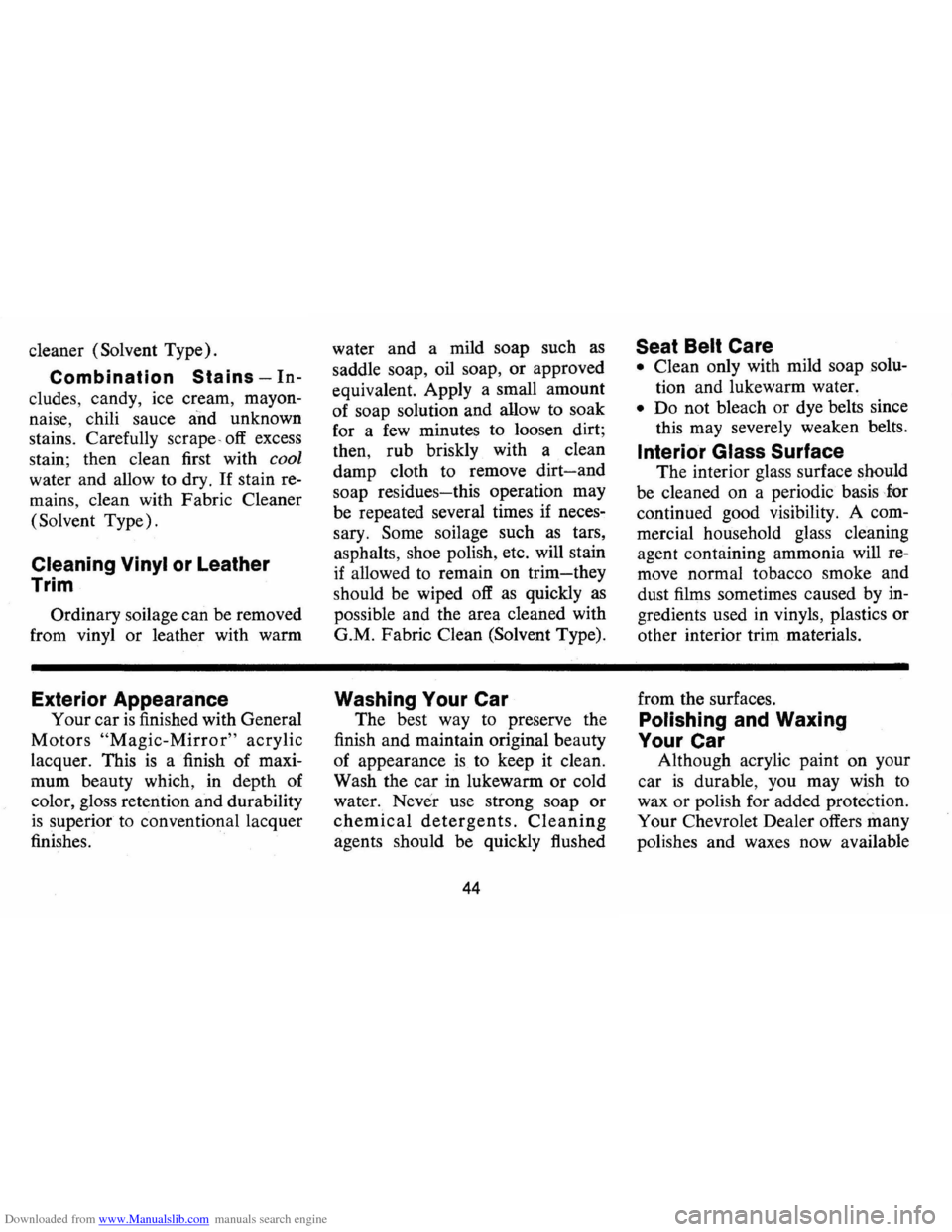
Downloaded from www.Manualslib.com manuals search engine cleaner (Solvent Type).
Combination Stains -In
cludes, candy, ice cream, mayon
naise, chili sauce
and unknown
stains. Carefully
scrape, off excess
stain; then clean first with
cool
water and allow to dry. If stain re
mains, clean with Fabric Cleaner
(Solvent Type).
Cleaning Vinyl or Leather
Trim
Ordinary soilage can be removed
from vinyl or leather with warm
Exterior Appearance
Your car is finished with General
Motors "Magic-Mirror" acrylic
lacquer. This
is a finish of maxi
mum beauty which, in depth of
color, gloss retention and durability
is superior to conventional lacquer
finishes. water
and a mild soap such
as
saddle soap, oil soap, or approved
equivalent. Apply a small amount
of soap solution and allow to soak
for a
few minutes to loosen dirt;
then, rub briskly with a clean
damp cloth to remove
dirt-and
soap residues-this operation may
be repeated several times if neces
sary. Some soilage such
as tars,
asphalts, shoe polish, etc. will stain
if allowed to remain on trim-they
should be wiped off as quickly as
possible and the area cleaned with
G.M. Fabric Clean (Solvent Type).
Washing Your Car
The best way to preserve the
finish and maintain original beauty
of appearance
is to keep it clean .
Wash the car in lukewarm
or cold
water.
Never use strong soap or
chemical detergents. Cleaning
agents should be quickly flushed
44
Seat Belt Care
• Clean only with mild soap solu
tion and lukewarm water.
• Do not bleach or dye belts since
this may severely weaken belts.
Interior Glass Surface
The interior glass surface should
be cleaned on a periodic basis ·f-or
continued good visibility. A com
mercial household glass cleaning
agent containing ammonia will re
move normal tobacco smoke and
dust
films sometimes caused by in
gredients used in vinyls, plastics
or
other interior trim materials.
from the surfaces.
Polishing and Waxing
Your Car
Although acrylic paint on your
car
is durable, you may wish to
wax
or polish for added protection.
Your Chevrolet Dealer offers
many
polishes and waxes now available
Page 48 of 85
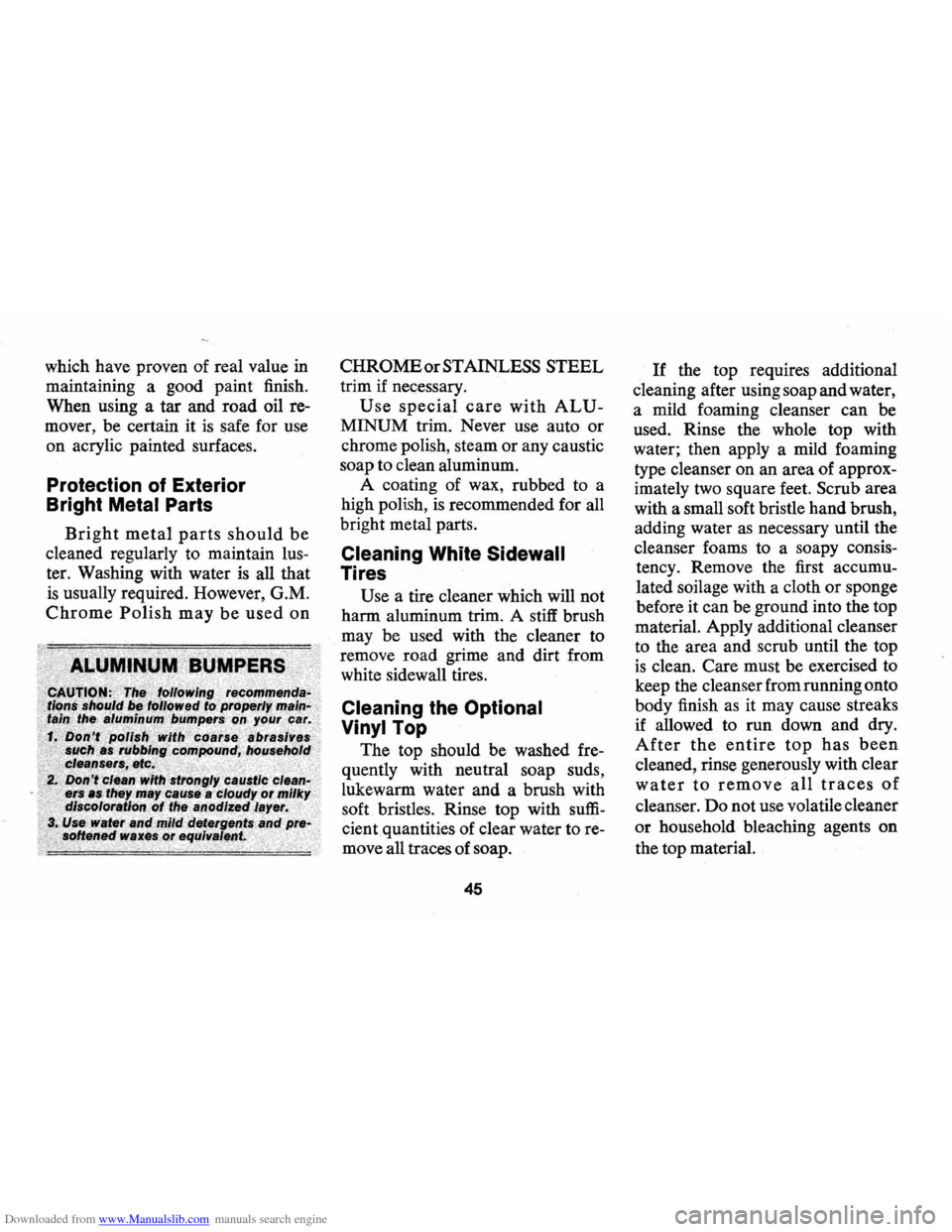
Downloaded from www.Manualslib.com manuals search engine which have proven of real value in
maintaining a good paint finish.
When using a tar and road oil re
mover, be certain it
is safe for use
on acrylic painted surfaces.
Protection of Exterior
Bright
Metal Parts
Bright metal parts should be
cleaned regularly to maintain lus
ter. Washing with water
is all that
is usually required. However, G.M.
Chrome Polish may be used on
CHROME or STAINLESS STEEL
trim if necessary.
Use special care with ALU
MINUM trim. Never use auto or
chrome polish, steam
or any caustic
soap to clean aluminum.
A coating of wax, rubbed to a
high polish,
is recommended for all
bright metal parts.
Cleaning White Sidewall
Tires
Use a tire cleaner which will not
harm aluminum trim. A stiff brush
may be used with the cleaner to
remove road grime and dirt from
white sidewall tires.
Cleaning the Optional
Vinyl
Top
The top should be washed fre
quently with neutral soap suds,
lukewarm water and a brush with
soft bristles. Rinse top with
suffi
cientquantities of clear water to re
move all traces of soap.
45
If the top requires additional
cleaning after using soap and water,
a mild foaming cleanser
can be
used. Rinse the whole top with
water; then apply a mild foaming
type cleanser on an area of approx
imately two square feet.
Scrub area
with a small soft bristle hand brush,
adding water
as necessary until the
cleanser foams to a soapy consis
tency. Remove the first accumu
lated soilage with a cloth
or sponge
before it can be ground into the top
material. Apply additional cleanser
to the area and scrub until the top
is clean. Care must be exercised to
keep the cleanserfrom running onto
body finish
as it may cause streaks
if allowed
to run down and dry.
After the entire top has been
cleaned, rinse generously with clear
water to remove all traces of
cleanser. Do not use volatile cleaner
or household bleaching agents on
the top material.
Page 56 of 85
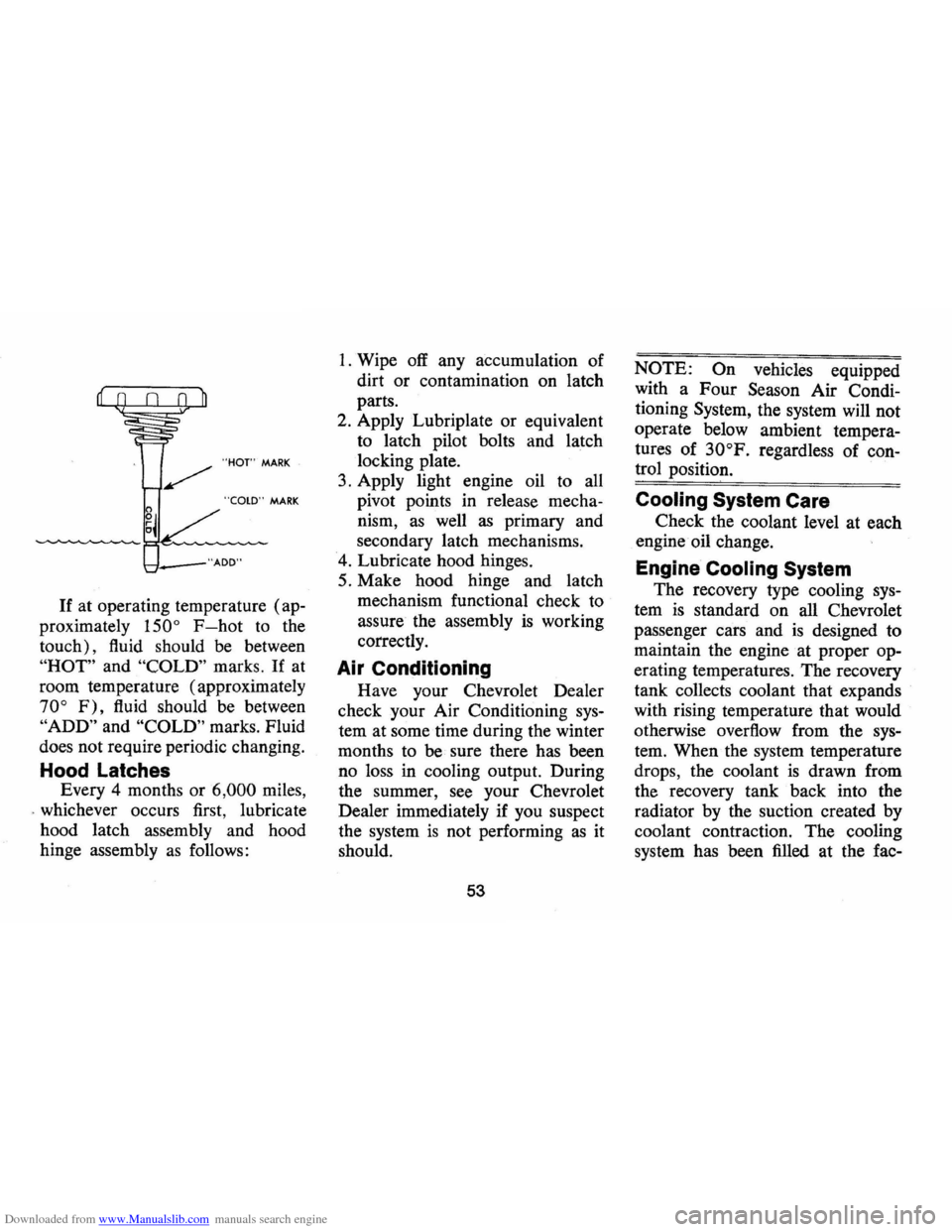
Downloaded from www.Manualslib.com manuals search engine "HOT" MARK
"COLD" MARK
>-f.. __ "AOO"
If at operating temperature (ap
proximately
150° F-hot to the
touch), fluid should be between
"HOT" and "COLD" marks. If at
room temperature (approximately
70° F), fluid should be between
"ADD" and "COLD" marks. Fluid
does not require periodic changing.
Hood Latches
Every 4 months or 6,000 miles,
. whichever occurs first, lubricate
hood latch assembly and hood
hinge assembly
as follows:
1. Wipe off any accumulation of
dirt or contamination on latch
parts.
2. Apply Lubriplate or equivalent
to latch pilot bolts and latch
locking plate.
3. Apply light engine oil to all
pivot points in release mecha
nism,
as well as primary and
secondary latch mechanisms.
4. Lubricate hood hinges.
5. Make hood hinge and latch
mechanism functional check to
assure the assembly
is working
correctly.
Air Conditioning
Have your Chevrolet Dealer
check your Air Conditioning
sys
tem at some time during the winter
months to
be sure there has been
no loss in cooling output. During
the summer,
see your Chevrolet
Dealer immediately if you suspect
the system
is not performing as it
should.
53
NOTE: On vehicles equipped
with a Four Season Air Condi
tioning System, the system will not
operate below ambient tempera
tures of
30°F. regardless of con
trol position.
Cooling System Care
Check the coolant level at each
engine · oil change.
Engine Cooling System
The recovery type cooling sys
tem is standard on all Chevrolet
passenger cars and
is designed to
maintain the engine at proper op
erating temperatures.
The recovery
tank collects coolant that expands
with rising temperature that would
otherwise overflow from the
sys
tem. When · the system temperature
drops, the coolant
is drawn from
the recovery tank back into the
radiator by the suction created by
coolant contraction. The cooling
system has been filled at the fac-
Page 74 of 85
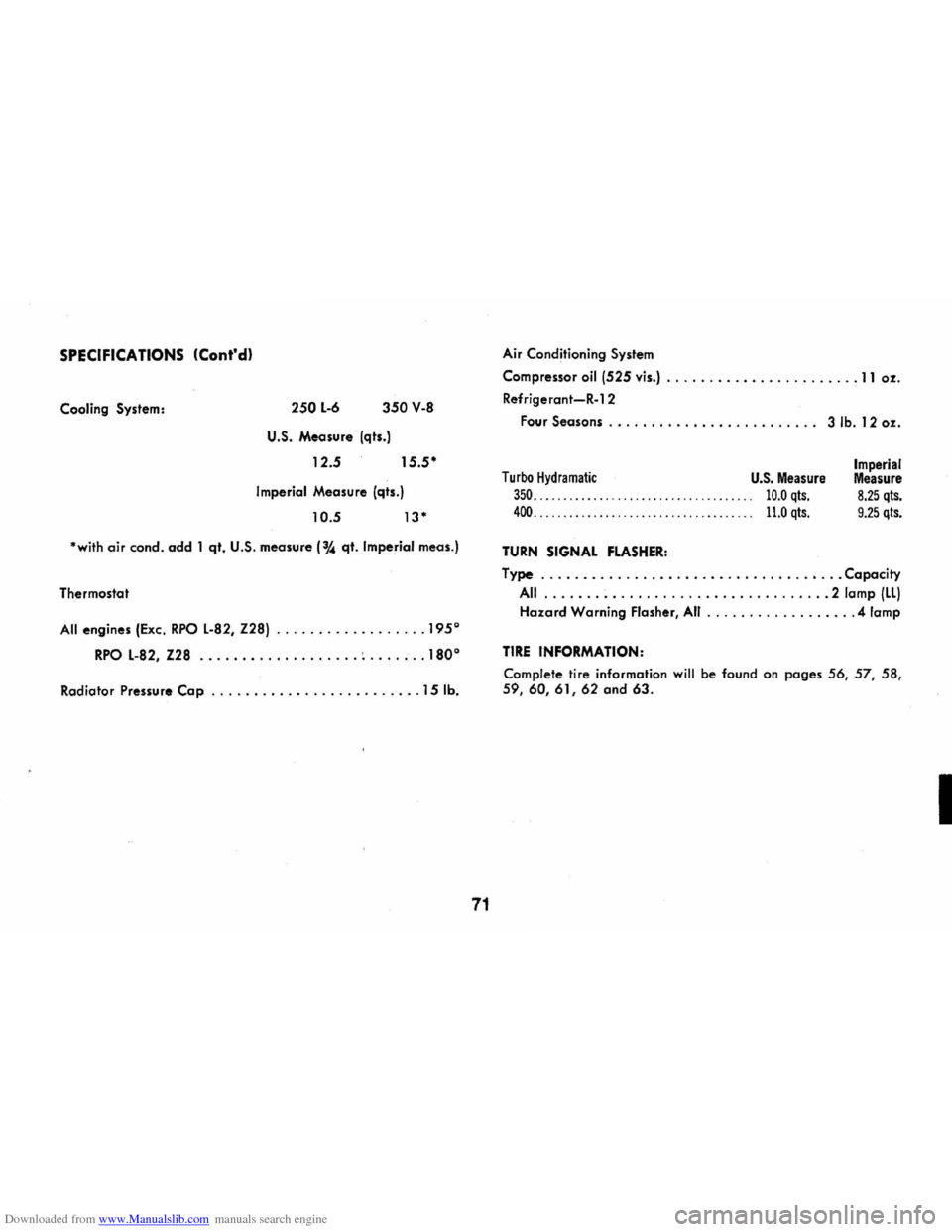
Downloaded from www.Manualslib.com manuals search engine SPECIFICATIONS (Cont'd)
Cooling System: 250 L-6 350 V-8
U.S. Measure (qts.)
12.5 15.5"
Imperial Measure (qts.)
10.5 13·
·with air condo add 1 qt. U.S. measure (3A qt. ,Imperial meas.)
Thermostat
All engines (Exc. RPO L-82, Z28) .................. 1950
RPO L-82, Z28 ................... ~ . . ..... 1800
Radiator Pressure Cap ......................... 15 lb.
71
Air Conditioning System
Compressor oil (525 vis.) ....................... 11 oz.
Refrigerant-R-1 2
Four
Seasons. . . . . . . . . . . . . . . . . . . . . . . .. 3 lb. 12 oz.
Turbo Hydramatic U.S. Measure
350............. ....................... 10.0 qts. 400. . . . . . . . . . . . . . . . . . . . . . . . . . . . . . . . . . . . . 11.0 qts.
TURN SIGNAL FLASHER:
Imperial Measure 8.25 qts. 9.25 qts.
Type .................................... Capacity
All .................................. 2 lamp (LL)
Hazard Warning Flasher, All .................. 4 lamp
TIRE INFORMATION:
Complete tire information will be found on pages 56, 57, 58, 59,60,61,62 and 63.
I
Page 75 of 85
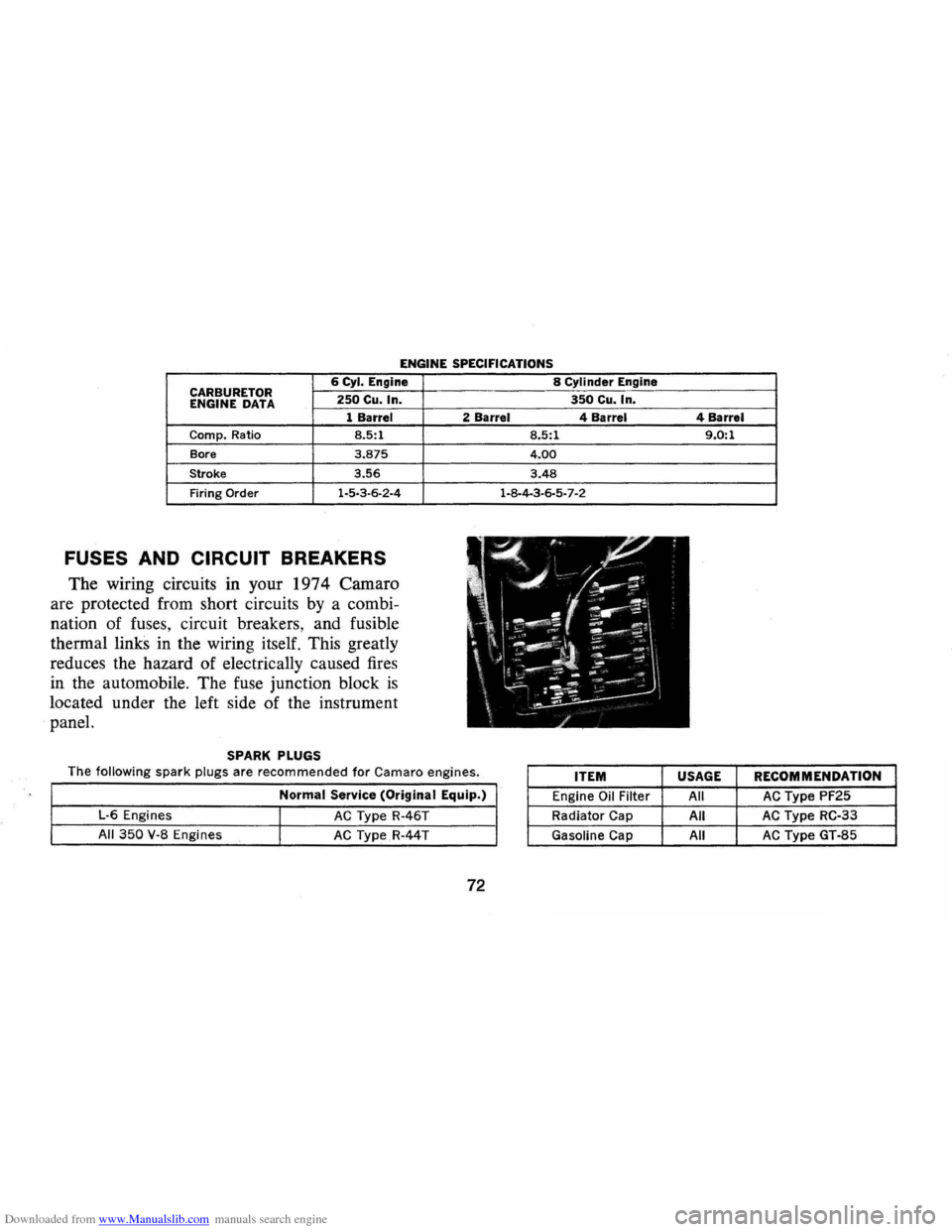
Downloaded from www.Manualslib.com manuals search engine ENGINE SPECIFICATIONS
6 Cyl. Engine 8 Cylinder Engine CARBURETOR 250 Cu. In. 350 Cu. In.
ENGINE DATA
1 Barrel 2 Barrel 4 Barrel
Camp. Ratio 8.5:1
Bore 3.875
Stroke 3.56
Firing
Order 1·5·3·6-2-4
FUSES AND CIRCUIT BREAKERS
The wiring circuits in your 1974 Camaro
are protected from short circuits by a combi
nation of fuses, circuit breakers, and fusible
thermal
linkS in the wiring itself. This greatly
reduces the hazard of electrically caused fires
in the automobile. The fuse junction block
is
located under the left side of the instrument
panel.
SPARK PLUGS
The
following spark plugs are recommended for Camaro engines.
Normal Service (Original Equip.)
L-G Engines I AC Type R-4GT
All
350 V-8 Engines I AC TypeR-44T
72
8.5:1
4.00
3.48
1-8-4-3-6-5-7-2
ITEM
Engine Oil Filter
Radiator Cap
Gasoline Cap 4
Barrel
9.0:1
USAGE RECOMMENDATION
All AC Type PF25
All
AC Type RC-33
All
AC Type GT-85